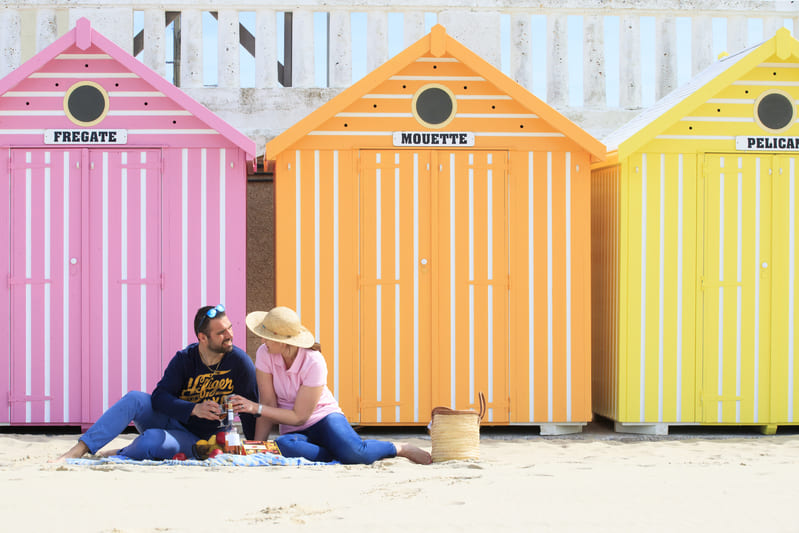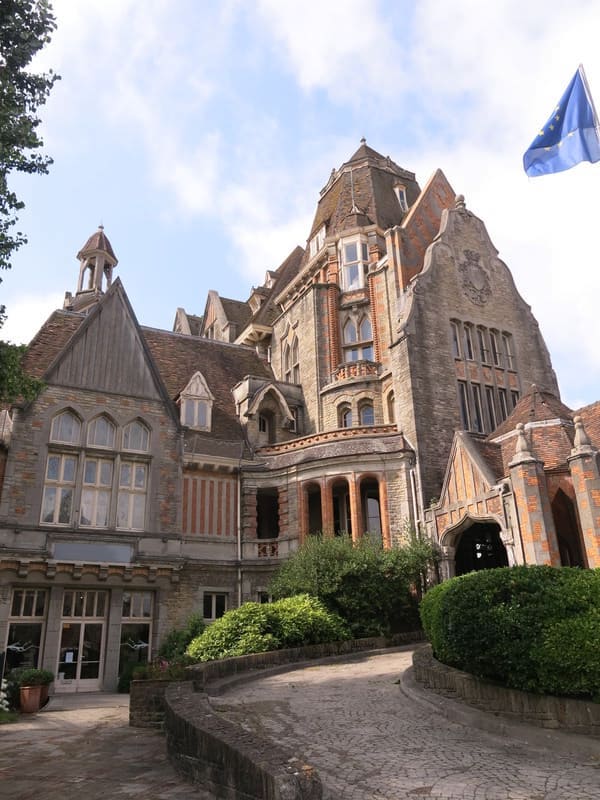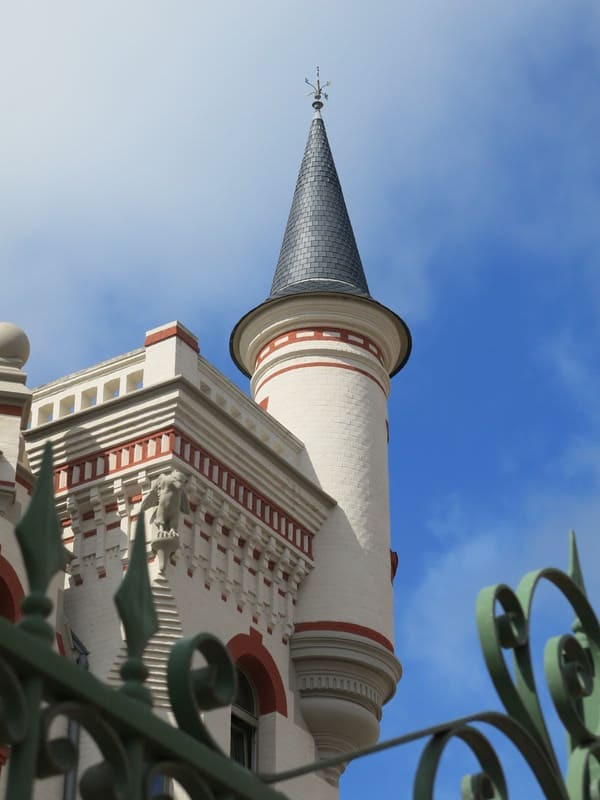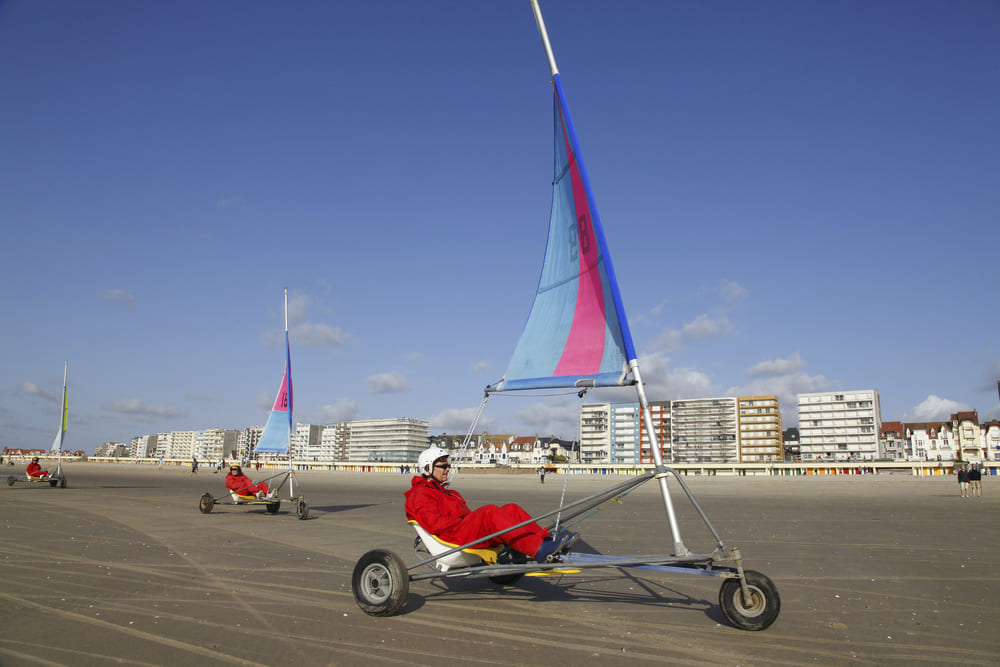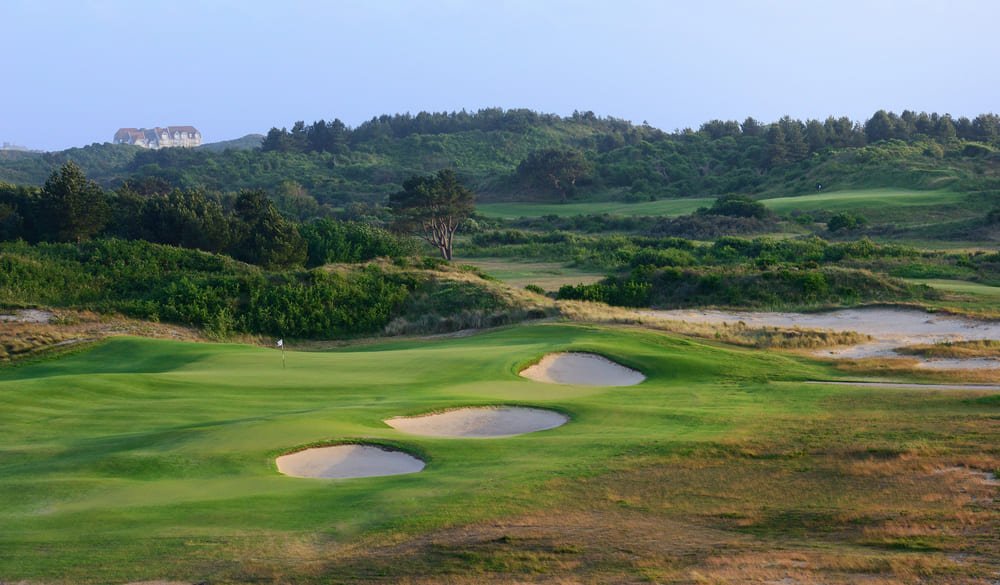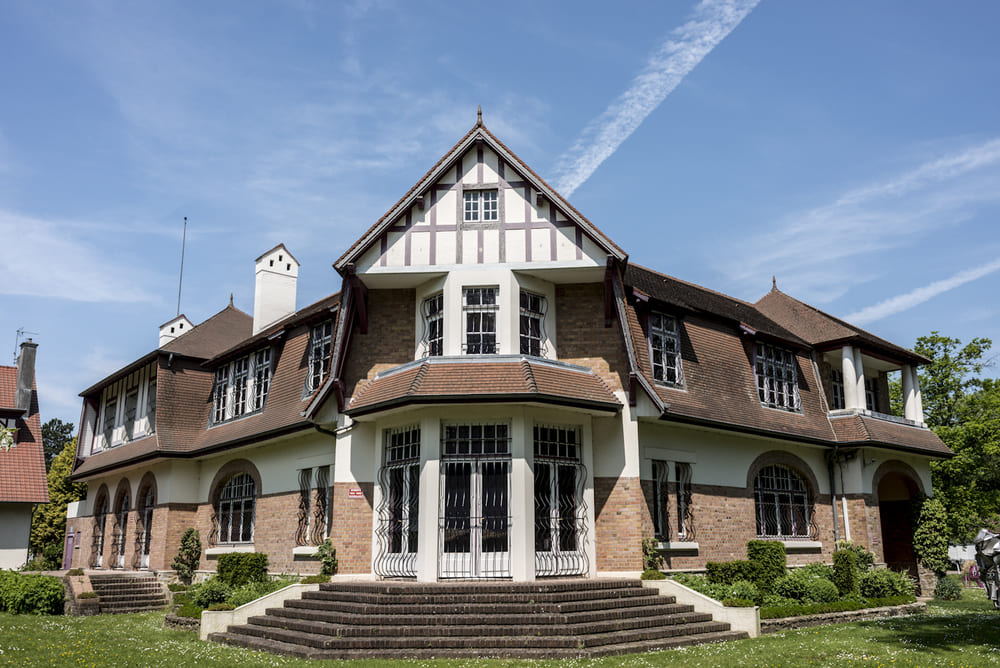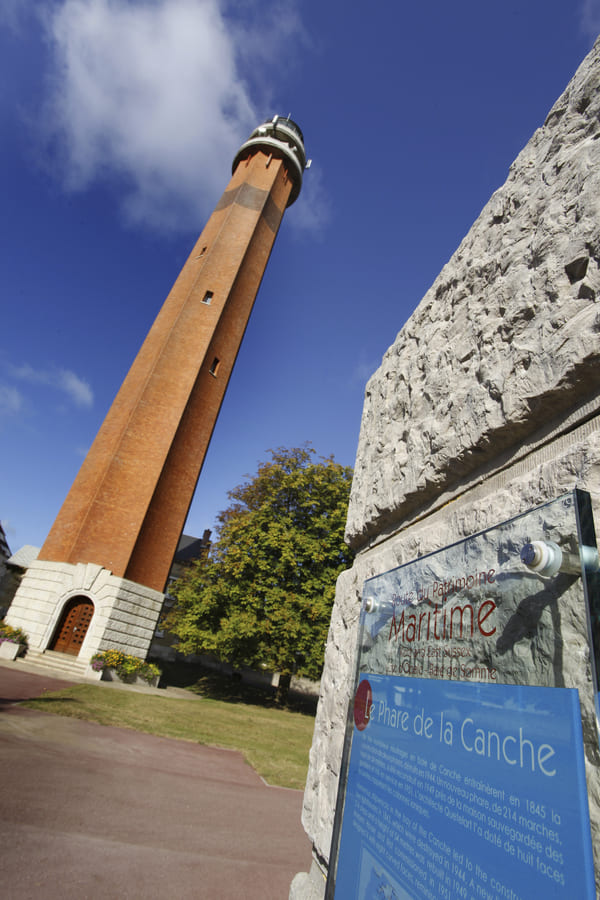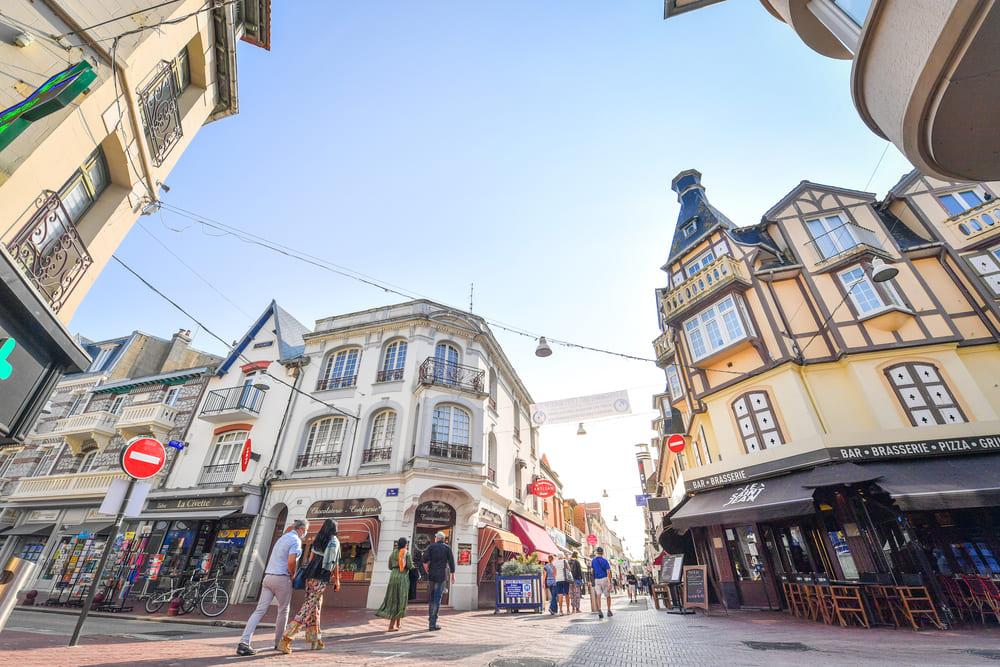Le Touquet, also known as Paris Plage
A short hop across the English Channel or a 3-hour drive from Paris, Le Touquet-Paris-Plage has it all. There are sandy beaches and water sports, cycle routes through the parks and leafy forest, tennis and golf, an excellent museum and a summer-long series of festivals.
Le Touquet has the dog-friendly “Toutourisme” certification, meaning dogs and dog owners are welcome and well taken care of.
Le Touquet has always exercised a seductive charm. By the 1920s it was the place to be for the rich and famous, writers, film stars and politicians. The British smart set and their French friends descended on the chic seaside resort for its golf, horse racing, and polo matches. They stayed in the grand hotels or in villas that range from Art Deco to neo classical, Gothic to Tudor, and gambled the night away in the casinos. Today’s visitors are mostly more low key, though you might spot French President Macron here!
Le Touquet best attractions
Town Hall
The Hôtel de Ville in Le Touquet is an appropriately striking building with its tall belfry, red brick Tudor details and neo gothic arches.
Financed by just one year’s profits from the town’s casino, it was opened on June 27, 1931.
A guided tour takes you into the building and the City Hall’s grand official salle d’honneur where the town dignitaries meet to keep Le Touquet on the fashionable map.
Post Office
Another of the landmarks of Le Touquet, the post office opened in 1927 on the site of the former 19th-century church of Saint-Jean.
Its triangular roof is deliberately ecclesiastical to recall its past, while the geometric design displays more than a touch of Art Deco.
It was designed by Jean Boissel after he won a competition organised by the town and the building became a historical monument in 1997.
The Racecourse Grandstands
The 1925 Hippodrome grandstands not only drew an international crowd to the chic resort, they were also renowned for their architectural innovations.
The project was one of the first by architects Georges-Henry Pingusson and Paul Furiet and the young team designed each grandstand with a state of the art single piece of reinforced concrete as an awning to cover the seats.
From the top rank of seats there’s a wonderful view over the course below and to the Canche river estuary beyond.
Town Hall – Le Touquet © Lydie Rault
Le Castel Villa – Le Touquet © Lydie Rault
Le Castel villa
Built in 1904, this white villa with its tall pointed tower and red brick window surrounds could have come out of a fairy tale. It’s one of the 20 or so Le Touquet buildings on the French Historic Monuments registry. Guided walks from the Tourist Office take in more of the architectural treasures of the town.
Casino Barrière le Touquet
The elegant casino in the Palais des Congrès was originally part of a villa built by Daloz, the founder of Le Touquet, in the 1860s. The expanded casino was used as a British military hospital in World War I then became the playground for the 1920s international jet set. The present casino was rebuilt in the 1950s in traditional Le Touquet style replacing the 1927 building. It particularly attracted the British whose gambling was restricted to member-only casinos at home. Ian Fleming used it as his model for Casino Royale, its high rollers as rich as the international set who frequented the gaming tables of the past.
Kiosk Serge Gainsbourg
Hidden in the Parc des Pins, the little music pavilion was opened in 1924 at the height of the roaring 20s. Used today by small bands during the summer festival season, it was renamed the Kiosk Serge Gainsbourg in 2001. The French singer-songwriter began his career as a crooner in Le Touquet and composed and first played one of his most famous song, Le Poinçonneur des Lilas, at the Club de la Forêt, now Le Flavio restaurant.
The Beach of le Touquet
Children build sandcastles, people walk their dogs along the 7 km-long stretch of golden sand, and in February, the famous Enduropale race sees some 1,000 motorbikes stream along the beach and through the dunes.
Sand yachting on the Opal Coast
Follow in the path of Louis Blériot who accelerated along the beach at Le Touquet in his aeroplage (beach plane) in 1910. A new sport was born though it wasn’t until the 1930s that Henry Demoury was renting out the land yachts he had built. You can learn the techniques to get you up to speed at the Base Nautique Sud and get some idea of the skill involved at the annual Blériot Cup held in May organised by the Blériot Club, which holds the honour of being the first char à voile club in the world.
Sand yacthing – Le Touquet © AS Flament
Le Touquet golf resort © Opengolfclub
Canche Nature Park
The park stretches over 42 hectares of protected dunes, pine trees and sandy beaches at the north tip of Le Touquet. Three walking routes wind through the park while a boardwalk leads to the observatory. Migratory birds like the nightjar, snipe and oyster catchers fly overhead; mammals and small creatures from wild boar to the common toad make the park their permanent home. If you’re lucky, you’ll see the occasional seal finding its way along the coast.
Le Touquet Golf Resort
Built in 1904, the Golf de la Forêt was from the start one of the best courses in Europe. It’s a 9-hole course, set among the dunes and forests, one of 3 golf courses in the resort. Le Manoir Hotel, just on the edge of the forest is clubby and very British.
Iconic Places to visit in Le Touquet
If you only have a short time, don’t miss these.
Museum – Le Touquet © Jean-David HESTIN
The Le Touquet Museum
Housed in the impressive Way Side villa built for a doctor in 1925 by Henri-Léon Bloch, the art collections of the Musée du Touquet-Paris-Plage cover the late nineteenth century to the present day. Unique to the museum, around 300 works from 1880 to 1914 show the Étaples post-Impressionist school. The works were produced by the 200 painters who flocked to the Opal coast from England, Germany, the USA, Australia and Scandinavia. Attracted by the seascapes, the clear luminescent light and the charming details of local life, their images run from intimate still lives to scenes where families, the women in long billowing skirts, stroll along the sandy beach. Black-and-white and sepia photographs depict major mid-20th century artists like Picasso and Cocteau and the celebrities such as Marcel Pagnol who flocked to the fashionable resort.
The Covered Market
In the Art Deco Marché couvert, stalls in the Poissonnerie section offer fish fresh off the local boats; elsewhere cheeses, vegetables and seasonal fruits vie for your attention. Designed by Henri-Léon Bloch and built between 1927 and 1932, this is the place where locals buy their preserves, local cheeses like the strong smelling Maroilles, strawberries in the spring and leeks and parsnips in winter. Visitors look through the books, clothes, linen tea towels and soaps in the stalls that spill out onto the surrounding spaces. Every Thursday and Saturday.
The Canche lighthouse
Originally two lighthouses constructed in the 1950s guarded this dangerous coastal stretch but they were destroyed by bombing in World War II. The present 57-metre high octagonal brick tower opened in 1951 by which time the lighthouse had been surrounded by the rapidly growing town. Climb the 274 steps to the top for a view over the elegant villas and the woods and dunes of the sparkling Opal coastline. On a clear day you can see north towards Calais, south to the Normandy cliffs, east to Montreuil and beyond and west to the white cliffs of Dover.
Lighthouse – Le Touquet © AS Flament
Town centre – Le Touquet © Yannick Cadart-CD62
Shopping
Le Touquet is a shopper’s paradise. Don’t miss the covered market for fruit, vegetables, household goods and a great atmosphere. The surrounding streets house plenty of small antiques shops and homeware boutiques to help furnish the town’s gracious villas; top food boutiques cater to every taste.
The shops are clustered around the network of streets in the centre, with rue Saint-Jean taking the prize. For good leather handbags, gifts, watches from the big French names from Lancel to Longchamp, try La Mascotte in rue St Jean.
Upmarket souvenirs are on offer at the Boutique de Melanie in rue de Moscou which sells the officially branded and produced Le Touquet items. With an oriental influence in its range of homewares, it’s also a great place to get unusual Christmas decorations if you’re in the town in winter.
Beny Boutique in rue de Londres specialises in chic items that will definitely give you the French touch, like the iconic metal egg basket that every kitchen should have. There’s also a good selection of brocante objects, from vintage coat hangers to small wooden tables.
Touquet Antic Garden in rue de Metz spills out into a courtyard with an inspiring jumble of antique urns, lamps, iron wall pieces and the odd rusty bicycle.
There’s another good collection of rural chic items at Abaca. Everything at this mix of café and boutique is organic, fair trade or from artisans, from tea, coffee and drinks to odd shaped wooden cutting boards, cushions, baskets, vases and more. And everything is for sale, so if you fancy your chair, just buy it.
Food shopping
Tea Together in Avenue Georges Besse was started by an English couple in the 90s. Now it’s run by their son who continues the tradition of making jam from organic fruit, marmalades and honey, while also stocking ketchups and mustards from specialist suppliers. No need to go top hotels they supply like the Dorchester Hotel’s 45 Pak Lane for their summer pudding jam; buy it here.
Salted butter or pecan nut biscuits, ginger confit and more can be bought individually or in attractive packets at La Manufacture du Touquet in rue Saint-Louis – and you can watch the specialist artisan producers making them.
Elizabeth’s Tea Rooms in rue de Metz is as English as the name implies. Just the place for those on a nostalgic journey who come here for the scones, lemon curd, fairy cakes and sausage rolls.
You can’t miss Au Chat Bleu in rue Saint-Jean with its distinctive blue and white awning and famous graphic of a cat with chocolate in its mouth. Since 1912 the shop has been making chocolates with gold leaf, chocolates flavoured with pistachio, orange, ginger, plus crystallized fruits of the sort that great aunts used to give at Christmas (but so much better here).
Chocolat Beussent Lachelle is a small chain of top chocolate shops in France. The bitter dark granache is irresistible…along with the bars of black chocolate from Tanzania beautifully packaged and the large selection of chocolate treats.
Perch at the oyster bar at Chez Perard in rue de Metz for a quick lunch, or buy your own crustaceans at the fish counter next door where you can also stock up on dishes of langoustines bouillabaisse or paella to take away.
More coastal towns to visit
Boulogne
Calais
Berck
Etaples
Top ten seaside attractions
See, do, eat and more
